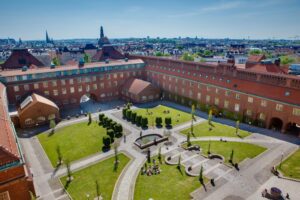
Quantum detectors used in research projects that form the basis of this year’s Nobel Prize in Physics were created by Professor Val Zwiller’s research group at KTH.
“Quantum teleportation has huge potential for society to save energy in the future. Information transfer over the internet using quantum technology, for example, requires just one photon rather than millions,” says Zwiller.
This year’s Nobel Laureate’s physics experiments have laid the foundation for the phenomenon of ‘nonlocality’, i.e. the fact that, say, two light particles (photons) that were once entangled in the same source can ‘sense’ what is happening to the other even at a distance. This phenomenon enables quantum teleportation.
In 2019, KTH Professor Val Zwiller and 2022 Nobel Laureate Anton Zeilinger published a joint scientific article on quantum communication. On that occasion the detectors, developed and installed by KTH and spin-off company Single Quantum, were used to measure quantum teleportation via fibre links over long distances.
Avoid interception
“We observed 257 photon pairs per second, which travelled a distance of 96 kilometres via a submarine optical telecommunications fibre between Malta and Sicily,” says Zwiller.
KTH Professor Val Zwiller and postdoc Thomas Descamps in the KTH laboratory
KTH Professor Val Zwiller and postdoc Thomas Descamps are collaborating on secure, energy-efficient communication channels, based on quantum teleportation using individual photons.
The research project looked at the possibility of a secure, submarine, device-independent communication channel between countries – an international quantum communication channel.
“In our ongoing research, we plan to create a quantum communication channel between KTH and a station in Finland. The aim is to be able to identify any attempts at interception in real time,” says Zwiller.
A major EU-wide development project is currently under way to provide more secure information transfer between all 27 Member States through a shared quantum cryptography network.
Internet surfing accounts for more than 10 percent of electricity consumption
“Greater information security is of course a vital benefit of future quantum communication. But I think the huge energy savings enabled by quantum technology will have an even greater impact on society,” says Zwiller.
According to him, calculations show that internet surfing today accounts for more than 10 per cent of total human consumption of electricity. And forecasts suggest that energy consumption for internet activity is set to snowball over the next five years.
Val Zwiller in laboratory at KTH
“Through quantum communication based on entangled photons, an essentially fully secure means of communication has been achieved, for the first time in history,” says Professor Val Zwiller of KTH.
As an example, he explains that viewing a ‘normal YouTube link’ requires millions of photons for every bit of information transferred.
“With quantum communication, only a few photons are needed. This will reduce power consumption for viewing an average YouTube video by a factor of billions, making the communications transfer virtually free of charge,” says Zwiller.
Ongoing quantum projects in the KTH lab
Quantum transfer through individual photons has future applications in areas such as medicine, radar technology, datacommunication and air measurements.
Val Zwiller’s research group at KTH is currently conducting experiments in quantum technology, whereby radar equipment measures distance and light via individual photons. With the new technology, high-resolution 3D images can be created in real time, at distances as long as one kilometre.
Nobel Prize in Physics 2022
This year’s Nobel Prize in Physics is awarded to Alain Aspect, John F. Clauser and Anton Zeilinger for research into quantum mechanics. Their findings contribute, among other things, to energy saving, more powerful computers, and more secure information sharing.
Another application for the group’s quantum detector in the KTH Lab is an air sensor, which measures air quality by registering how the light is absorbed by different gases in the air. The air sensor can be used to measure, for example, carbon dioxide levels in different parts of the atmosphere.
Working with the Karolinska Institute, a quantum microscope is also being developed for in-depth imaging in living organisms, such as in the brain.
“And for the past couple of years, my research group has been studying quantum teleportation via an optical fibre extending 17 kilometres between the lab in Albanova to the Ericsson lab in Kista. We have been working with quantum detectors since 2017, and we are continuing our work to develop the technology further.”


